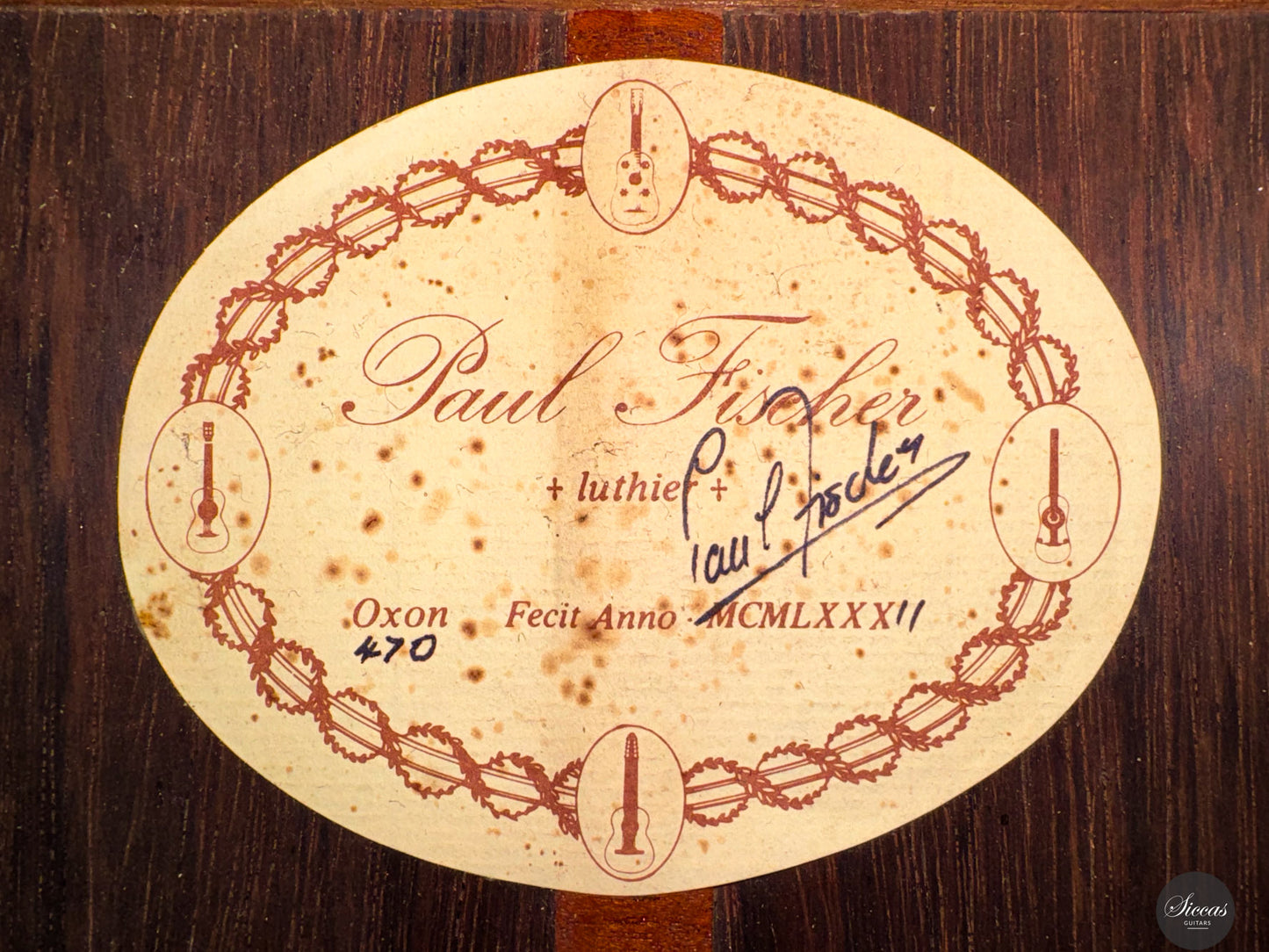Paul Fischer - 1982 - No. 470
Paul Fischer - 1982 - No. 470
Details
Details
Overview
Overview
Shipping important note
Shipping important note
Delivery times are typically reliable and most instruments arrive within the estimated timeframe.
Should any unexpected delay occur, our team will keep you informed and provide support at every step. For all shipping details and exceptions, please see our Shipping Policy.
Details about GPSR
Details about GPSR

























Video overview


More details about the guitar
About the luthier
Paul Fischer, born on the Isle of Man and raised in Oxford, began his career in instrument making under the guidance of harpsichord builder Robert Goble, where he was trained in the finest European tradition. He furthered his studies at the Oxford College of Art and Technology before meeting the late David Rubio in Duns Tew, Oxfordshire. Rubio’s workshop was an important hub visited by leading guitarists such as Julian Bream and John Williams, and Fischer served there as chief instrument maker and workshop manager. During this time, his guitars were produced under the Rubio label with the mark “P.F,” many of which remain in circulation today. In 1975 Fischer established his own studio, and in 1983 he received a Winston Churchill Travelling Fellowship to carry out research in the forests of Brazil. Beyond his building, Fischer has acted as an advisor to the Southern Arts Association and the Crafts Council of Great Britain. His instruments, frequently noted for their elegance and tonal qualities, are featured in major publications such as Richard Chapman’s The Complete Guitarist (1993) and John Morrish’s The Classical Guitar: A Complete History (1997). With decades of work dedicated to the evolution of the modern concert guitar, Fischer stands among the most respected British luthiers of his generation.About the guitar
This guitar, built in 1982, reflects Fischer’s mature craftsmanship during a period when he had already established himself as one of Britain’s foremost makers. Constructed in the traditional style, it features a spruce top paired with Brazilian rosewood back and sides, the latter dating from before CITES restrictions. The instrument is finished with French polish and fitted with Rodgers tuning machines, weighing 1655 grams. Tonally, the guitar presents an intimate and refined voice. The sound is soft and silky, with a long sustain that allows both bass and treble voices to ring clearly. One of its most striking qualities is the evenness of the first string, an attribute rarely found even in more recent instruments. The timbre has a piano-like clarity, balanced with enough brilliance to project convincingly in a concert hall. The guitar responds sensitively to right-hand dynamics, making it both comfortable to play and highly expressive. The overall tonal character is pleasant and lyrical rather than forceful, ideally suited for a wide range of repertoire.Condition
The guitar is in excellent condition for its age. There are no cracks, and the structure is entirely sound. The top bears normal playing marks and light superficial scratches, but no deep wear. The French polish is in good condition. The original Rodgers tuners function precisely. This is both a fine concert instrument and a highly collectible example of Fischer’s work, distinguished by its Brazilian rosewood and refined tonal qualities.Regular care extends the life of the instrument
Even with careful use, a classical guitar may gradually change in appearance or respond to unstable storage conditions. Have a close look at your guitar regularly and be attentif to changes. If your instrument is suffering from its environement, it will let you know.
Protect Your Guitar: Handle with Care
Be mindful when touching your instrument with greasy or unwashed hands: any skin contact is a small attack on the varnish. Of course, a guitar is made to be played, but taking a few precautions helps preserve its beauty: wash your hands before playing, wear long sleeves, and avoid unnecessary direct skin contact with the body of the instrument.
Pro tip: Avoid playing with a button-up shirt, heavy jewelry, or a belt, as these can scratch the guitar. Also, make sure your guitar case is free of any objects that could damage the instrument during storage.
String care
A good habit to adopt is wiping down your strings briefly after each playing session. This small action significantly extends their lifespan and helps maintain a consistent, comfortable feel under your fingers.
Most importantly, clean strings are essential for keeping your instrument in tune. Corrosion, sweat, and dust can affect the uniformity of the strings and interfere with accurate tuning across the entire fingerboard.
Pro tip: If you're having trouble getting your guitar in tune, it might be time to change the strings. A useful test is to compare the pitch of the 12th fret harmonic with the fretted note at the 12th fret; if there's an unusually large gap between them, your strings may have lost their integrity and should be replaced.
Keep Your Shellac Finish Shining!
Got a guitar with a shellac (French polish) finish? Here's a simple trick: Take a clean microfiber cloth and gently breathe on the surface to create a light mist. Then, softly rub to remove fingerprints, sweat, and grease. That’s usually all it takes to keep it looking great, no products needed!
Pro tip: Every few years, treat your guitar to a check-up with a luthier to keep it in top shape.
Storing Your Guitar: Climate Matters
Your guitar can safely stay outside its case, as long as the surrounding environment maintains 42–55% humidity and a temperature between 18–25°C.
Keep in mind that humidity levels can still fluctuate inside the case, especially during seasonal changes.
- Too much humidity may cause overtightened strings and a dull tone.
- Too little humidity can lead to a bulging top, string buzz, or even cracks.
Avoid placing your guitar near radiators, air conditioners, or windows with direct sunlight.
Pro tip: Always close your guitar case while playing. This helps preserve a stable microclimate inside the case, so your instrument is protected the moment you put it back in.





















































